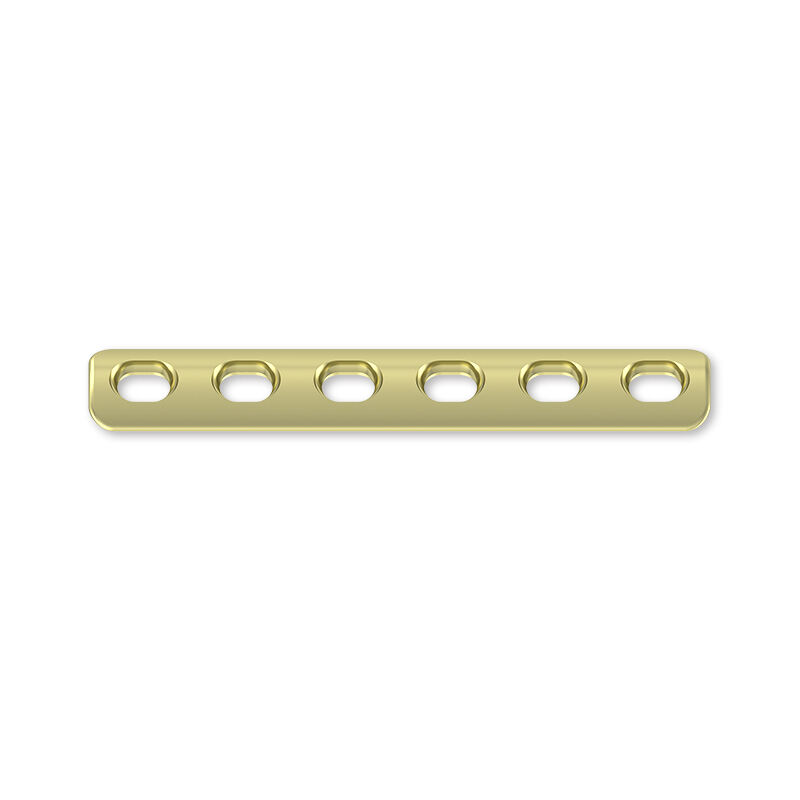Introduction
Humerus Interlocking Nails have transformed upper limb surgery by offering unparalleled stability and precision. These devices enable surgeons to address complex fractures with greater accuracy. Patients benefit from reduced recovery times and fewer complications. This innovation has redefined orthopedic practices, ensuring better outcomes and advancing surgical techniques to meet modern healthcare demands.
Overview of Humerus Interlocking Nails
Definition and Purpose
Humerus Interlocking Nails are advanced Orthopedic Implants designed to stabilize fractures in the upper arm bone, or humerus. These nails are cylindrical rods inserted into the bone's medullary canal. They feature locking screws at both ends to secure the implant in place. This design prevents rotational and axial movement, ensuring proper alignment during the healing process. The primary purpose of these nails is to provide internal fixation for fractures, enabling faster recovery and reducing the risk of complications. Their minimally invasive nature makes them a preferred choice for modern surgical procedures.
Role in Upper Limb Surgery
In upper limb surgery, Humerus Interlocking Nails play a critical role in addressing complex fractures. Surgeons rely on these implants to restore the structural integrity of the humerus while preserving surrounding tissues. Their use minimizes the need for extensive surgical exposure, which reduces trauma to muscles and soft tissues. This approach not only enhances surgical precision but also promotes quicker rehabilitation. By offering a reliable solution for fracture stabilization, these nails have become an essential tool in orthopedic surgery.
Common Applications in Fracture Management
Humerus Interlocking Nails are commonly used to treat a variety of fractures, including diaphyseal, comminuted, and pathological fractures. They are particularly effective in managing fractures caused by high-impact trauma or osteoporosis. Surgeons also utilize these nails for non-union fractures, where the bone fails to heal naturally. Their versatility extends to both acute and chronic cases, making them a valuable asset in fracture management. The ability to customize nail length and diameter further enhances their adaptability to different patient needs.
Innovations in 2025
Advancements in Nail Design
In 2025, humerus interlocking nails feature groundbreaking design improvements. Engineers have optimized the geometry of these implants to enhance their biomechanical performance. Modern designs incorporate tapered ends and variable locking options, which allow surgeons to address a wider range of fracture patterns. These innovations improve the implant's ability to distribute stress evenly, reducing the risk of implant failure. Additionally, modular designs enable surgeons to customize the nails during surgery, ensuring a precise fit for each patient. This adaptability has elevated the standard of care in orthopedic procedures.
Use of Biocompatible and Durable Materials
Material science advancements have significantly influenced the development of humerus interlocking nails. Manufacturers now use high-strength titanium alloys and advanced polymers to create implants that are both lightweight and durable. These materials exhibit excellent biocompatibility, minimizing the risk of adverse reactions. Enhanced corrosion resistance ensures the implants maintain their structural integrity over time. Furthermore, the use of bioactive coatings promotes better integration with the bone, accelerating the healing process. These material innovations have made the implants safer and more effective for long-term use.
Integration of Smart Technologies
Smart technologies have revolutionized the functionality of humerus interlocking nails. Sensors embedded within the implants now provide real-time data on bone healing and implant performance. Surgeons can monitor this data remotely, enabling proactive adjustments to treatment plans. Some designs also include wireless communication features, allowing seamless integration with hospital systems. These advancements improve surgical outcomes by offering unprecedented insights into the recovery process. The integration of smart technologies represents a significant leap forward in orthopedic care.
Benefits for Patients and Surgeons
Faster Recovery and Reduced Complications
Humerus Interlocking Nails have significantly improved recovery timelines for patients. Their minimally invasive design reduces surgical trauma, preserving the surrounding soft tissues and muscles. This approach minimizes post-operative pain and inflammation, allowing patients to regain mobility sooner. The precise alignment provided by these implants ensures proper bone healing, which lowers the risk of complications such as malunion or non-union. Additionally, the use of biocompatible materials reduces the likelihood of adverse reactions, further enhancing patient safety.
Enhanced Precision in Surgical Techniques
These implants have elevated the precision of upper limb surgeries. Surgeons benefit from advanced features like modular designs and variable locking options, which allow for tailored solutions during procedures. The integration of smart technologies provides real-time feedback on implant positioning and bone healing, enabling surgeons to make data-driven decisions. This level of accuracy reduces the margin for error, ensuring optimal outcomes. By streamlining complex procedures, Humerus Interlocking Nails have become indispensable tools in modern orthopedic surgery.
Long-Term Patient Outcomes
Patients experience lasting benefits from these innovative implants. The durable materials used in their construction ensure long-term stability, reducing the need for revision surgeries. Enhanced bone integration promotes natural healing, leading to stronger and more resilient bones. Over time, patients report improved functionality and reduced discomfort in the affected limb. These outcomes not only improve quality of life but also reduce healthcare costs associated with prolonged treatments or complications. The transformative impact of Humerus Interlocking Nails continues to set new benchmarks in patient care.
Challenges and Limitations
Design and Implementation Issues
Humerus interlocking nails, despite their advancements, face challenges in design and implementation. Engineers often struggle to balance strength and flexibility in the implants. Overly rigid designs can hinder natural bone movement, while excessive flexibility may compromise stability. Surgeons also encounter difficulties when aligning the nails with complex fracture patterns. Misalignment during insertion can lead to complications, such as implant failure or delayed healing.
Note: Precision in manufacturing and surgical planning remains critical to overcoming these issues. Collaboration between engineers and surgeons can help refine designs for better outcomes.
Cost and Accessibility Barriers
The high cost of humerus interlocking nails limits their accessibility in many regions. Advanced materials like titanium alloys and bioactive coatings significantly increase production expenses. Hospitals in low-income areas often cannot afford these implants, leaving patients without access to optimal care.
-
Key factors contributing to cost barriers:
- Expensive raw materials.
- Advanced manufacturing processes.
- Integration of smart technologies.
Governments and healthcare organizations must address these barriers to ensure equitable access to these life-changing devices.
Training Requirements for Surgeons
The use of humerus interlocking nails demands specialized training. Surgeons must master techniques for precise insertion and alignment. The integration of smart technologies adds another layer of complexity, requiring familiarity with data interpretation and device connectivity.
Tip: Regular workshops and simulation-based training programs can help surgeons stay updated on the latest techniques. Institutions should prioritize these initiatives to enhance surgical proficiency.
Without adequate training, the risk of complications increases, potentially negating the benefits of these advanced implants.
Future Outlook
Potential for Further Technological Integration
Humerus interlocking nails are poised to benefit from further technological advancements. Engineers are exploring the integration of artificial intelligence (AI) to enhance surgical planning. AI algorithms could analyze patient-specific data, such as bone density and fracture patterns, to recommend optimal nail configurations. Augmented reality (AR) systems may also assist surgeons by overlaying real-time imaging during procedures, improving accuracy. Additionally, future implants could feature enhanced smart sensors capable of monitoring healing progress with greater precision. These developments aim to create a seamless connection between technology and surgical expertise, elevating patient care to unprecedented levels.
Expanding Applications in Orthopedics
The versatility of humerus interlocking nails suggests their potential use in broader orthopedic applications. Researchers are investigating their effectiveness in treating fractures in other long bones, such as the femur and tibia. Pediatric orthopedics may also benefit from scaled-down versions of these implants, designed to accommodate growing bones. Furthermore, their use in managing bone deformities and reconstructive surgeries could expand significantly. By adapting these implants to diverse clinical scenarios, orthopedic surgeons can address a wider range of conditions with improved outcomes.
Long-Term Impact on Surgical Practices
The adoption of humerus interlocking nails will likely redefine surgical practices over the next decade. Surgeons will rely more heavily on data-driven tools and minimally invasive techniques, reducing the physical demands of traditional procedures. Training programs will evolve to incorporate advanced technologies, ensuring that future surgeons are well-equipped to handle these innovations. As these implants become more accessible, global healthcare systems will experience a shift toward more efficient and effective orthopedic care. This evolution will set new standards for patient outcomes and surgical excellence.
Humerus Interlocking Nails have redefined upper limb surgery by combining advanced design, durable materials, and smart technologies. These innovations have improved patient outcomes and surgical precision. Their transformative impact continues to set new standards in orthopedic care. Future advancements promise even greater integration of technology, ensuring these implants remain at the forefront of surgical innovation beyond 2025.
FAQ
What makes humerus interlocking nails different from traditional implants?
Humerus interlocking nails provide superior stability and precision. Their minimally invasive design reduces tissue damage, while advanced materials and smart technologies enhance healing and long-term outcomes.
Are humerus interlocking nails suitable for all patients?
Not all patients qualify for these implants. Surgeons evaluate factors like fracture type, bone quality, and overall health to determine suitability. Pediatric and elderly patients may require alternative solutions.
How do smart technologies improve surgical outcomes?
Smart technologies offer real-time data on bone healing and implant performance. Surgeons use this information to adjust treatment plans, ensuring optimal recovery and reducing the risk of complications.

